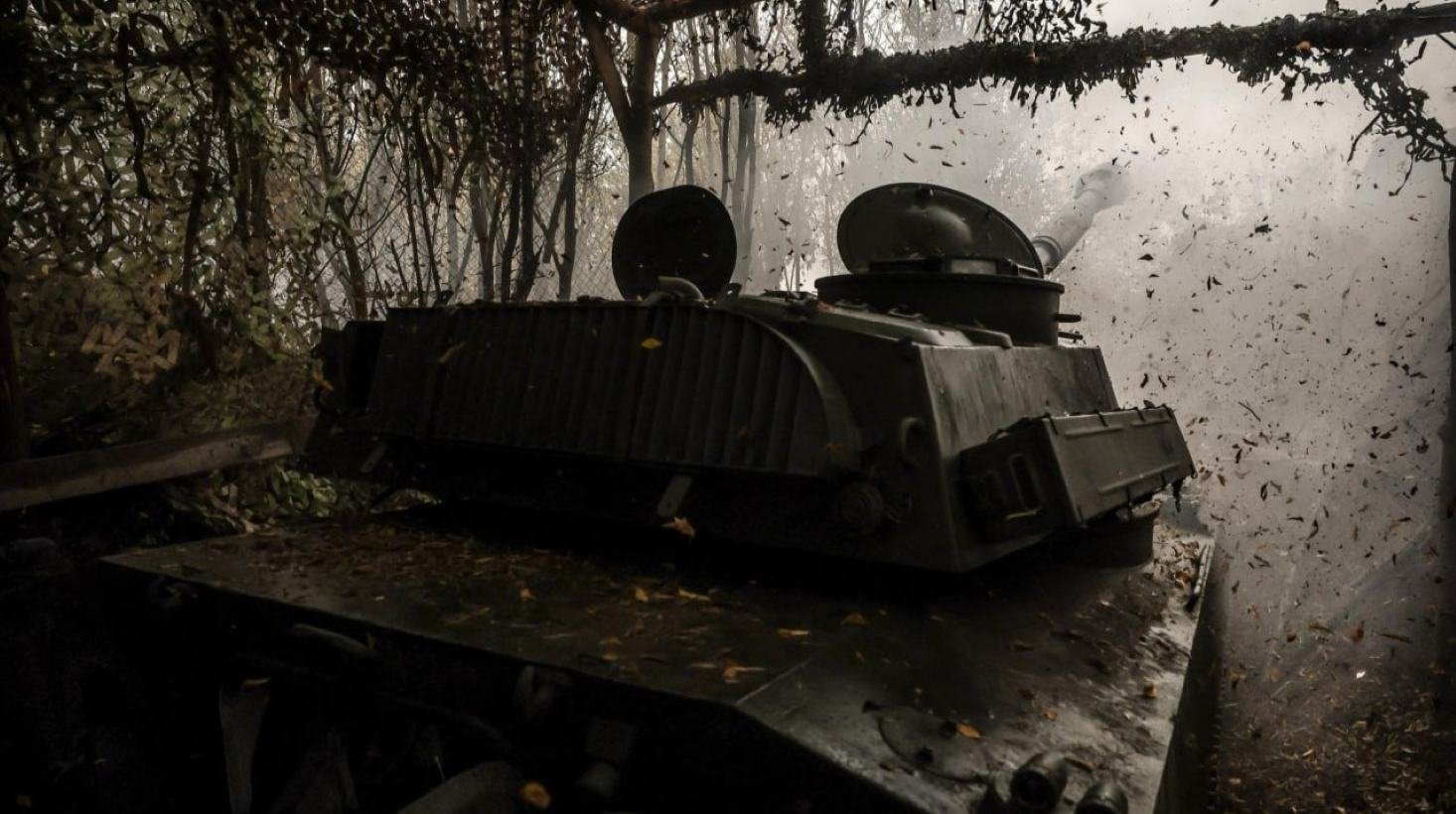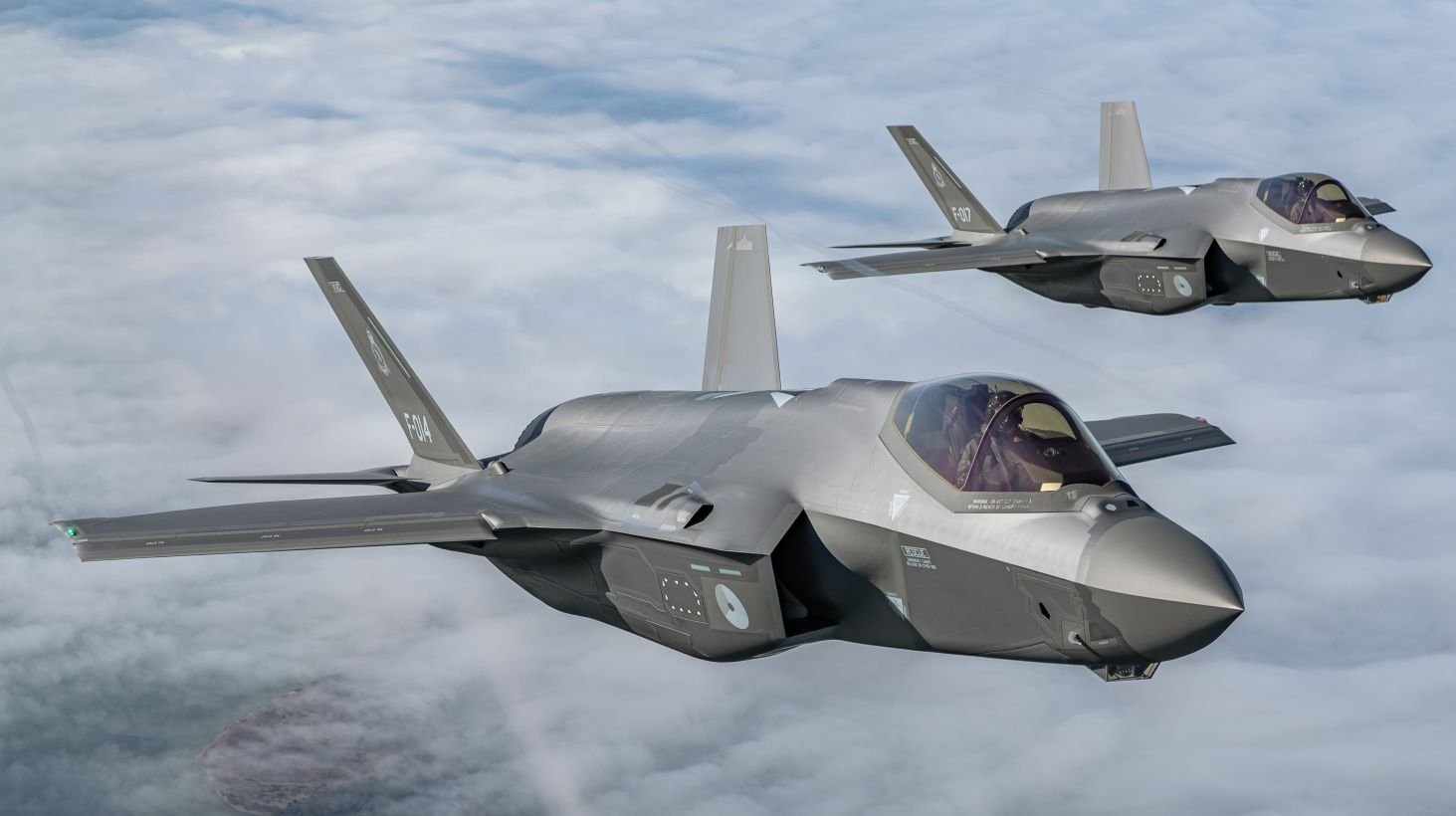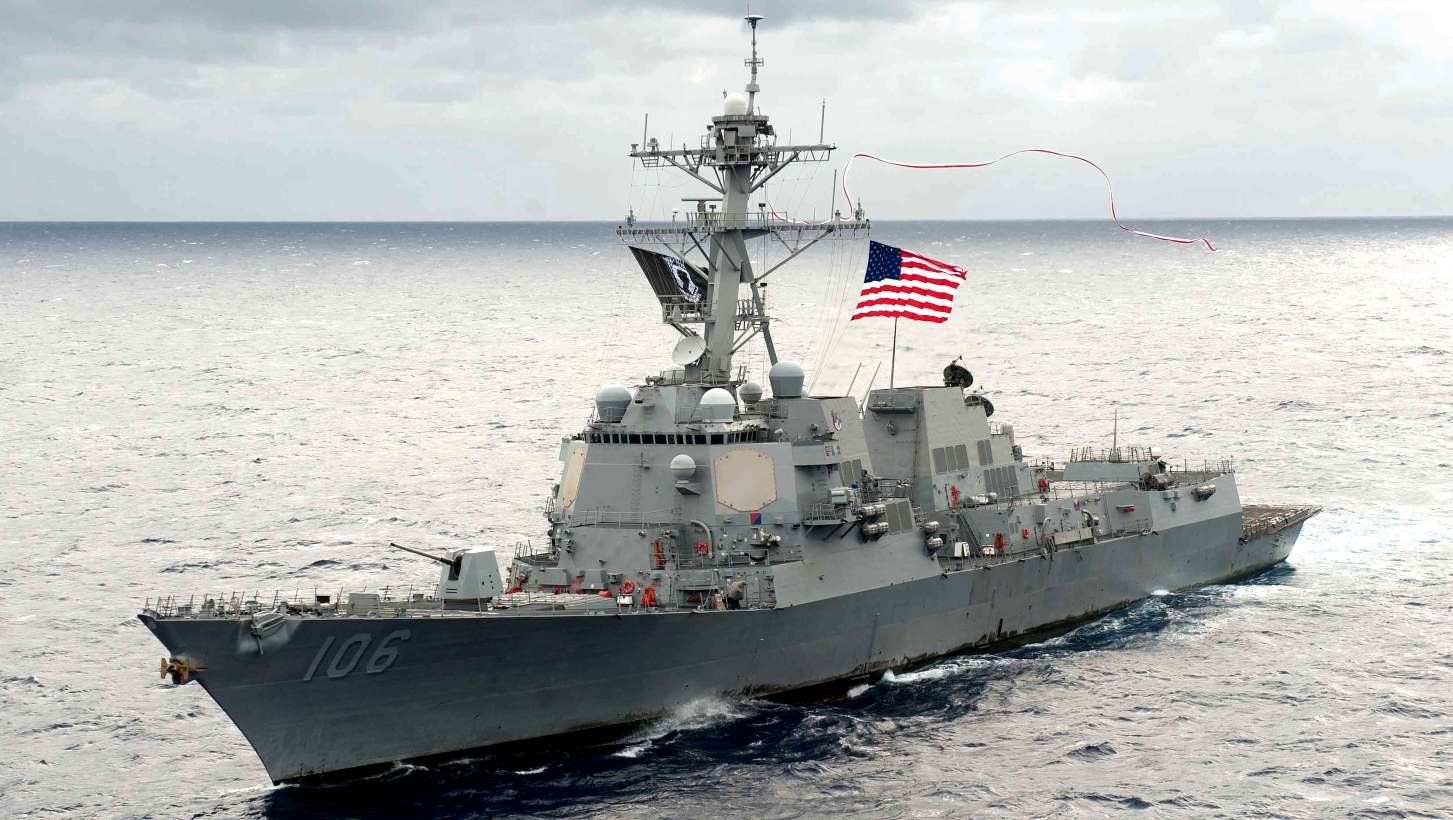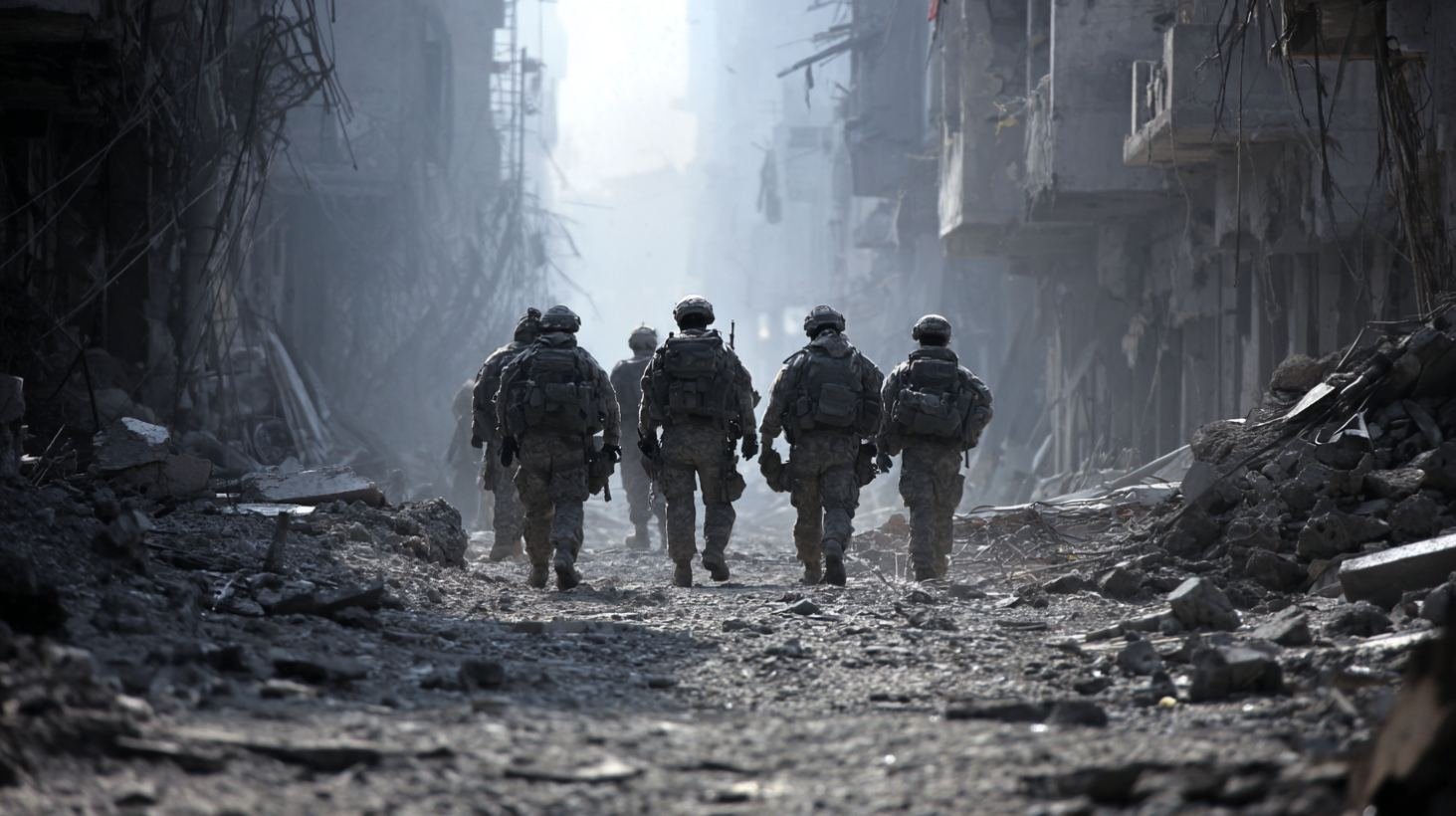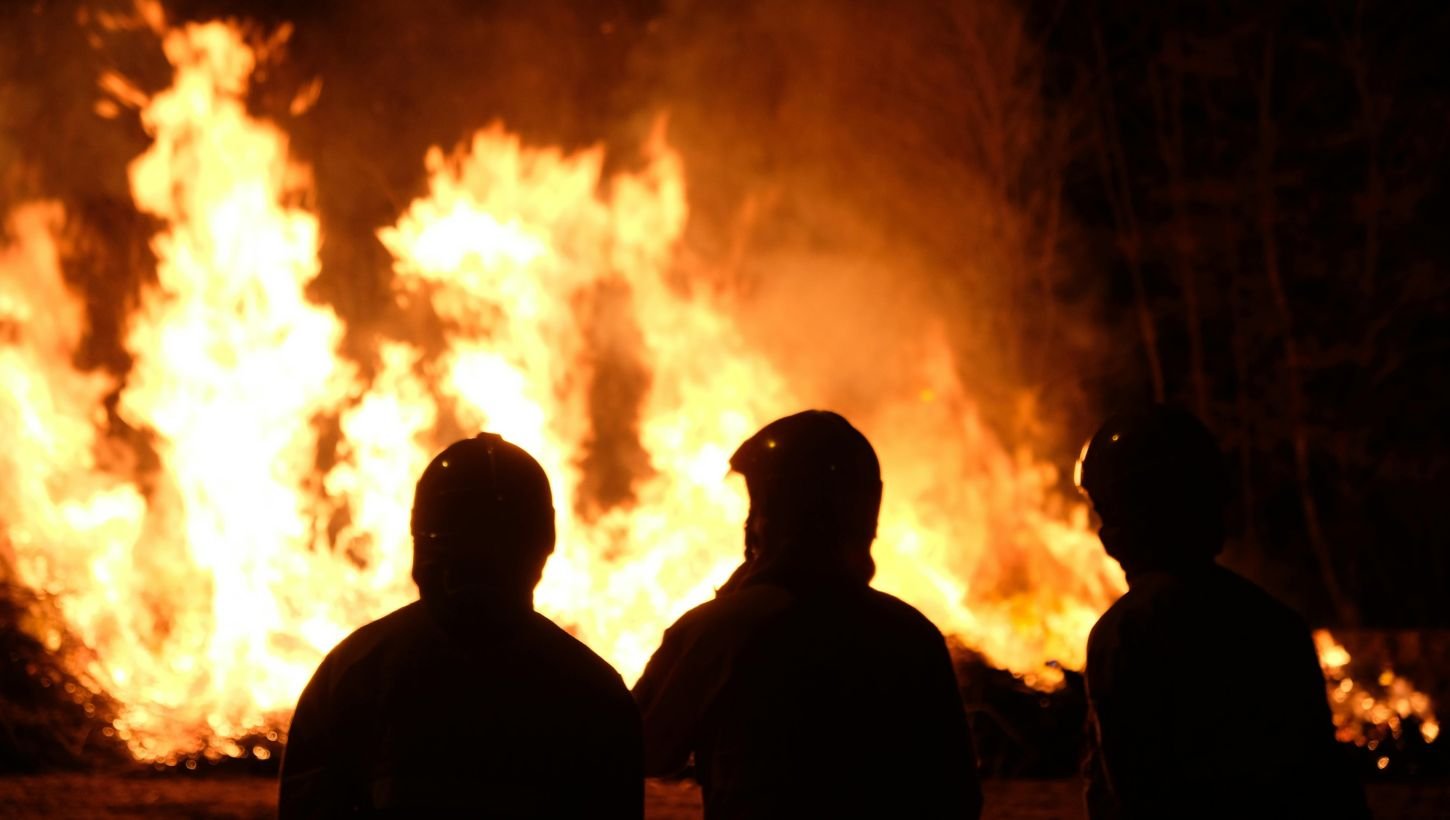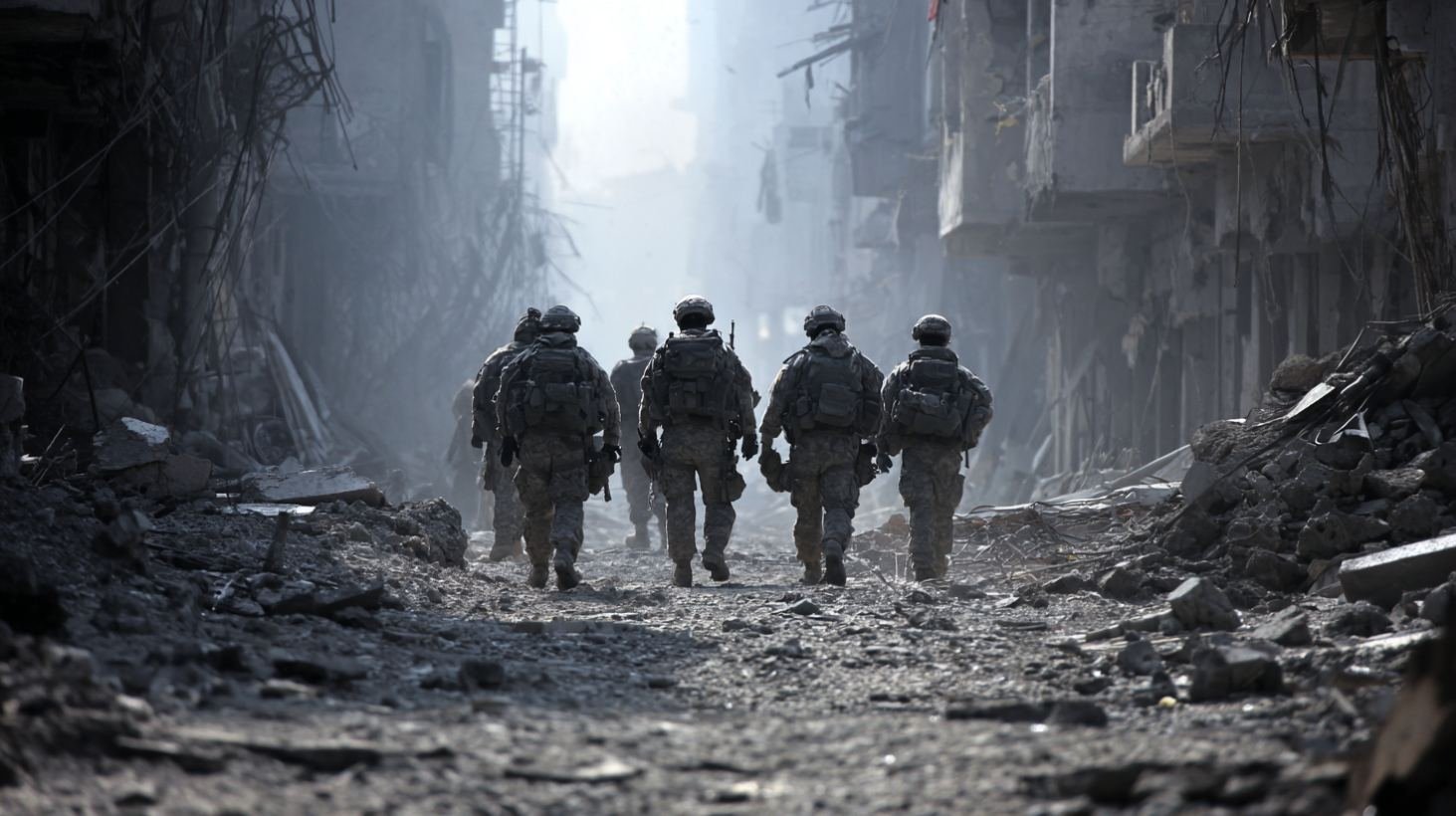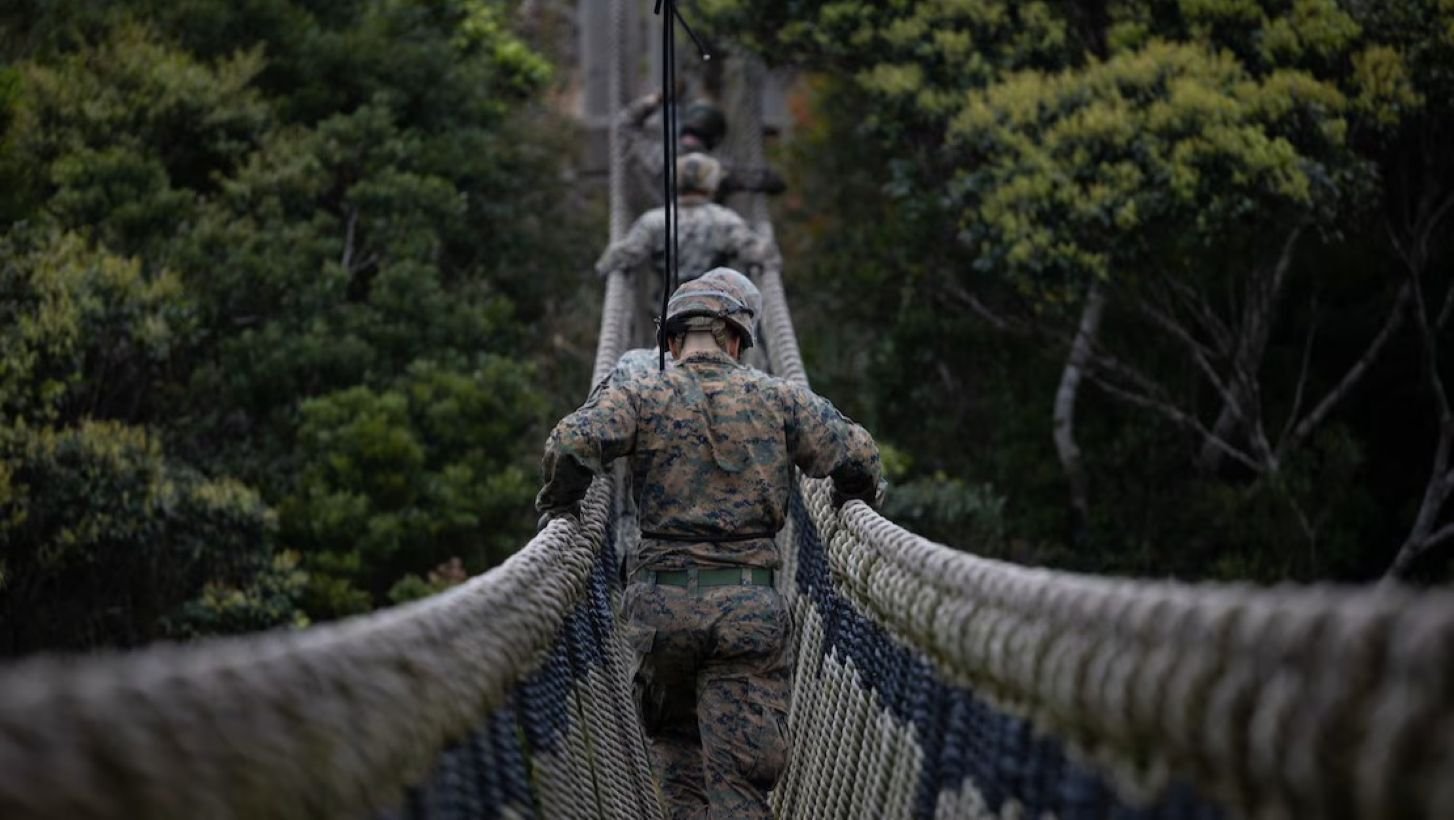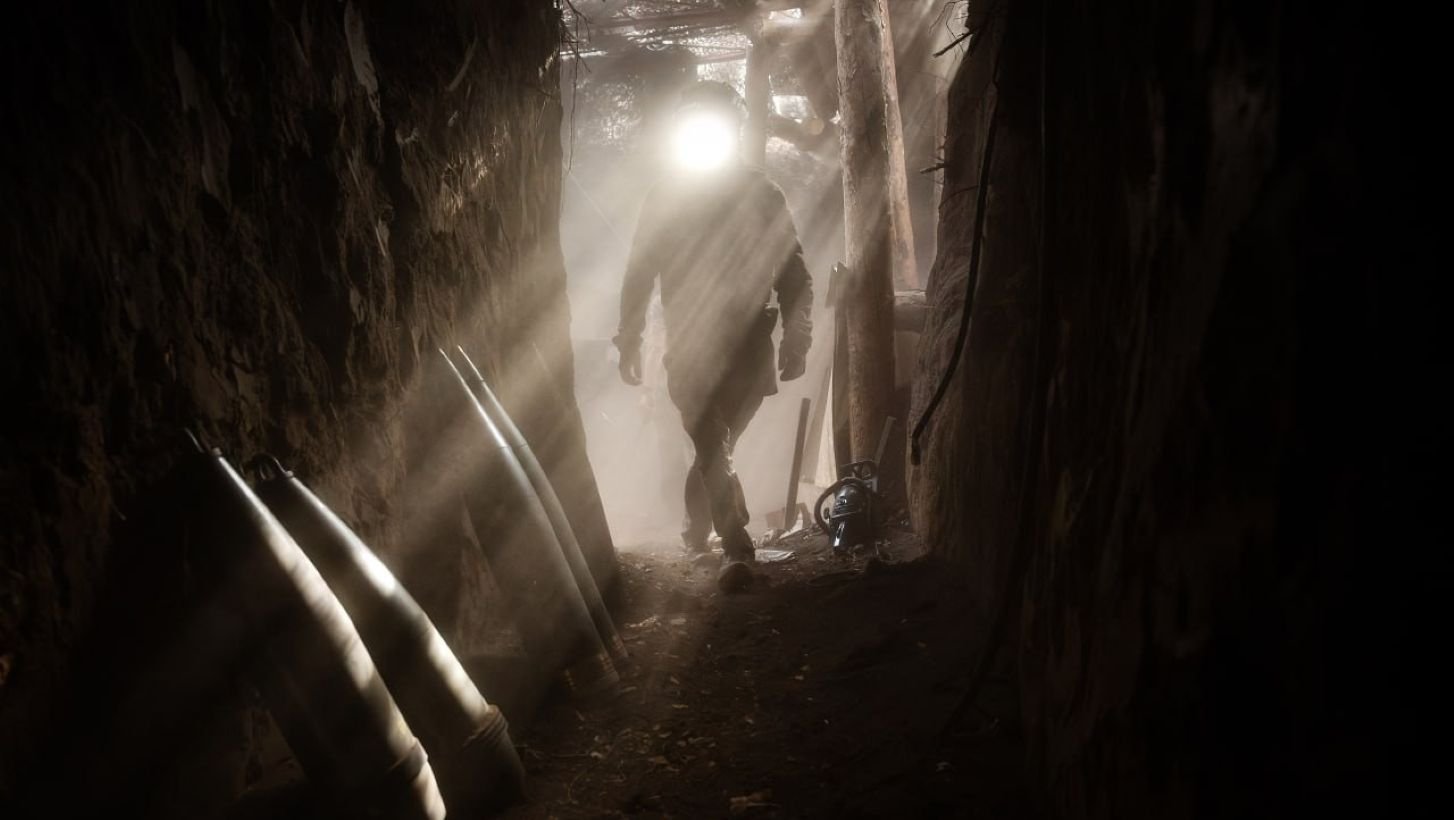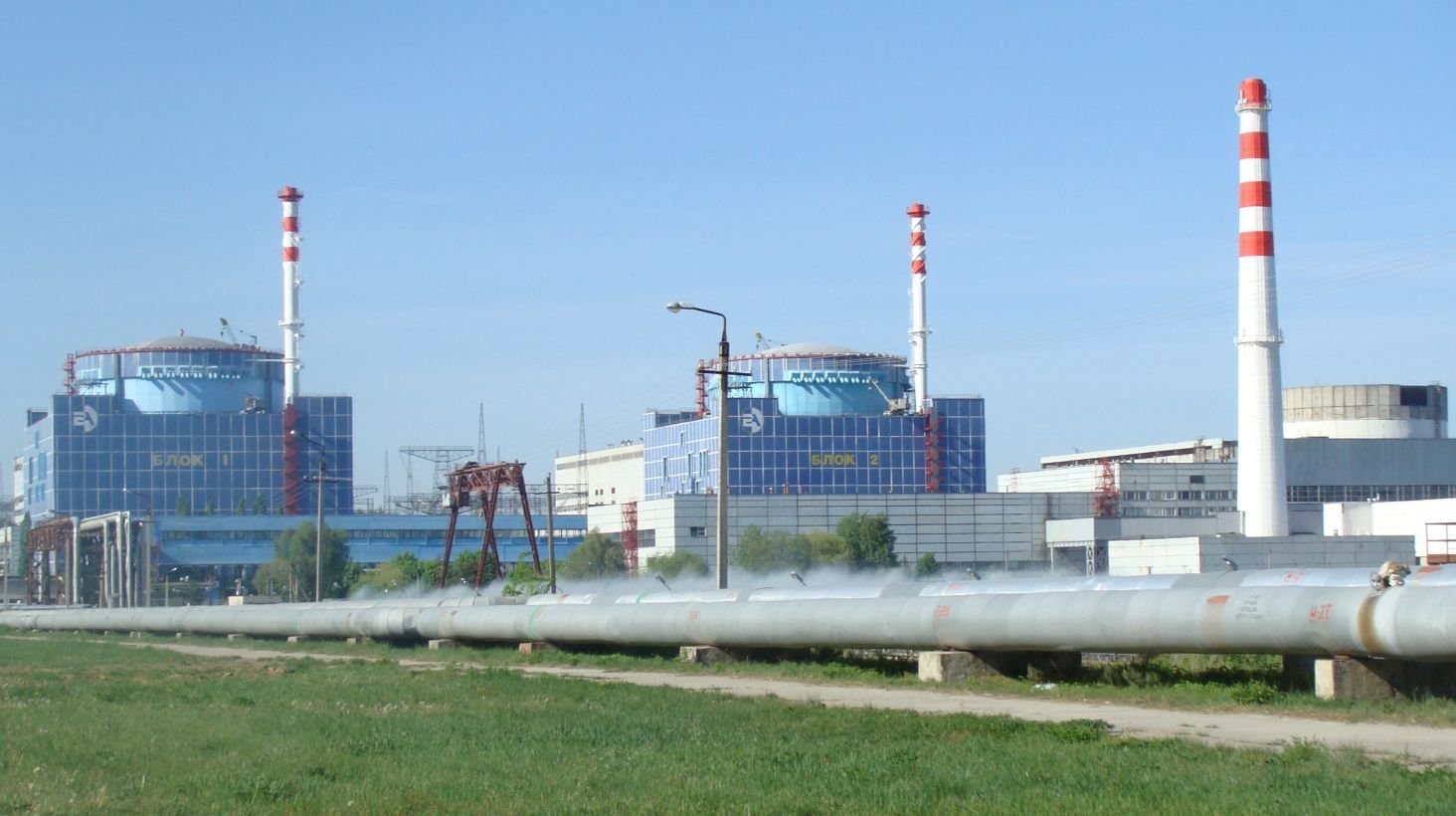-
Posts
790 -
Joined
-
Last visited
Content Type
Profiles
Uncrowned Armory News
Prepping Cookbook
Conspiracy Theories
Uncrowned Tactical Sports News
Prepping
Forums
Events
Everything posted by Uncrowned Guard
-
Peace Framework Stirs Security Concerns for Ukraine’s Future As Russia and Ukraine edge toward discussions on a potential peace agreement, leaked details about proposed terms have sparked significant debate within security circles. The focal point: grave restrictions on Ukraine’s future military capabilities and strategic alliances. Experts warn that these terms, if enacted, could carry serious risks for Ukraine’s long-term sovereignty and the broader regional balance. Military Restrictions: Stabilization or Vulnerability? Drafts of the prospective framework reveal sweeping limits—capping the size of Ukraine’s armed forces, banning advanced long-range weaponry, and prohibiting future military alliances or basing of foreign troops. Analysts on both sides of the Atlantic highlight an inherent asymmetry: Ukraine, already heavily outmatched by Russia’s military might and lacking nuclear arms, poses little offensive threat to its neighbor. Instead, critics argue, these restrictions would disproportionately affect the very state that suffered invasion, effectively asking Ukraine to tie its own hands. Security researchers and Western officials note that limitations targeting Ukraine’s defense infrastructure do not appear designed to prevent Ukrainian aggression—something virtually all observers deem impossible—but rather serve to restrain Kyiv’s ability to deter future attacks. No Allies on the Ground: The Dilemma of Security Guarantees Among the most contentious issues are proposals barring foreign military deployments on Ukrainian soil and forbidding mutual defense pacts, echoing longstanding Russian demands. Such provisions, experts warn, would preclude Ukraine from accessing collective security mechanisms akin to NATO protections, instead leaving it reliant on short-term aid and non-binding assurances. This “non-aligned” status, while intended to allay Moscow’s concerns, could in practice leave Ukraine critically exposed if hostilities flare anew. Independent analysts and government advisors alike caution that these arrangements could institutionalize Ukraine’s vulnerability, placing faith in Russian compliance and international goodwill, rather than enforceable commitments. Fears of Future Escalation Remain Acute Ukraine has already endured two major Russian interventions—in 2014 and 2022. Many specialists stress that the current military balance, alongside Moscow’s history of disregarding prior agreements, amplifies fears that restrictive peace terms could invite renewed aggression. Scholarly institutes such as ISW and RUSI have documented that Russian strategic aims in Ukraine often revolve around securing long-term leverage through constraints on its neighbor’s independence. With Russia actively modernizing and increasing its military capacity, skepticism is growing among European policymakers. There is a resounding concern that a weakened Ukrainian security posture could open the door to further coercive pressure or military incursions—risks not confined to Ukraine alone. European Voices Demand Credible Deterrence Frontline states across Eastern Europe have become especially vocal, warning that partial or unenforceable guarantees for Ukraine could destabilize the entire region. For these nations, the question is not merely about ending the current war, but preventing the resurgence of hostilities down the line. They argue that any settlement curtailing Ukraine’s defense or alliances could encourage Moscow to test the resolve of other European borders. Ukrainian leaders and civil society organizations concur, emphasizing the need for durable security mechanisms. Past agreements, they remind negotiators, have frequently been honored in the breach rather than the observance—underscoring the critical need for credible and enforceable guarantees. The Central Dilemma: Pausing War Versus Achieving Peace As deliberations continue, the heart of the debate remains unchanged: Will limiting Ukraine’s military capacity deliver a genuine, lasting peace, or will it merely grant Russia an opening for future escalation? With much at stake, regional stability may hinge on how negotiators balance the demands of immediate conflict resolution against the imperatives of deterrence and national security. View full article
-
- ukraine
- peacekeeping
-
(and 2 more)
Tagged with:
-
Russian Forces Secure Strategic Villages in Donetsk and Zaporizhzhia In a significant development along the eastern Ukrainian front, Russian forces have seized control of two villages—Promin in Donetsk Oblast and Vysoke in Zaporizhzhia Oblast—according to reports from Ukrainian analytical group DeepState. The move marks a continued advance by Russian units as the winter fighting season approaches, intensifying pressure on beleaguered Ukrainian defenses. Strategic Losses Mark Shifting Front Lines Promin, situated near Myrnohrad, has become a flashpoint. While Myrnohrad itself remains under Ukrainian control, it is now nearly encircled after a month of steady Russian gains in the neighboring city of Pokrovsk. This latest capture deepens the threat to Ukrainian positions and complicates supply lines in an already embattled sector. Meanwhile, Vysoke's fall northeast of Huliaipole signals a changing dynamic in Zaporizhzhia. Huliaipole, long considered a relatively stable stronghold, now finds itself facing fresh risks amid Russia’s escalated push into eastern Zaporizhzhia Oblast. The loss reverberates strongly, given the area’s prior resilience throughout the span of the full-scale invasion. Widespread Clashes Across the Front Data from Ukraine’s General Staff underscores the breadth of Russian offensive activity. The Pokrovsk sector witnessed the heaviest combat, with 41 skirmishes recorded in a single day. The Lyman area in northern Donetsk also saw significant conflict, tallying 35 clashes as fighting flared up in multiple zones. Despite speculation about isolated pockets of Ukrainian troops being surrounded near Huliaipole, the General Staff issued a statement denying such claims but acknowledged the situation remains “tense.” Conditions Favor Russian Tactics Throughout the autumn, challenging weather—marked by heavy fog and persistent rain—has played to the strengths of Russian tactics. These conditions have allowed Moscow’s forces to advance via dispersed, agile infantry units, who utilize limited visibility to maneuver against Ukrainian defenders. Visual evidence from Pokrovsk attests to Russia’s on-ground presence, with footage circulating of Russian soldiers moving with apparent ease through the city center. Such imagery not only exemplifies the gravity of recent territorial losses but also signals the confidence of advancing Russian elements. Ukrainian Counteroffensives Continue Amid Setbacks Despite mounting challenges, Ukrainian forces have persisted with localized counterattacks and clearance operations in newly lost territories. However, none of these efforts have resulted in a verified rollback of Russian territorial gains as of now. The twin losses of Promin and Vysoke underscore the growing complexity of Ukraine’s defense ahead of the winter. Analysts warn that Russian momentum, unless blunted, could lead to further strategic vulnerabilities for Ukrainian positions along the southeastern front, as Moscow appears determined to consolidate gains before winter’s full arrival.
-
Russian Forces Secure Strategic Villages in Donetsk and Zaporizhzhia In a significant development along the eastern Ukrainian front, Russian forces have seized control of two villages—Promin in Donetsk Oblast and Vysoke in Zaporizhzhia Oblast—according to reports from Ukrainian analytical group DeepState. The move marks a continued advance by Russian units as the winter fighting season approaches, intensifying pressure on beleaguered Ukrainian defenses. Strategic Losses Mark Shifting Front Lines Promin, situated near Myrnohrad, has become a flashpoint. While Myrnohrad itself remains under Ukrainian control, it is now nearly encircled after a month of steady Russian gains in the neighboring city of Pokrovsk. This latest capture deepens the threat to Ukrainian positions and complicates supply lines in an already embattled sector. Meanwhile, Vysoke's fall northeast of Huliaipole signals a changing dynamic in Zaporizhzhia. Huliaipole, long considered a relatively stable stronghold, now finds itself facing fresh risks amid Russia’s escalated push into eastern Zaporizhzhia Oblast. The loss reverberates strongly, given the area’s prior resilience throughout the span of the full-scale invasion. Widespread Clashes Across the Front Data from Ukraine’s General Staff underscores the breadth of Russian offensive activity. The Pokrovsk sector witnessed the heaviest combat, with 41 skirmishes recorded in a single day. The Lyman area in northern Donetsk also saw significant conflict, tallying 35 clashes as fighting flared up in multiple zones. Despite speculation about isolated pockets of Ukrainian troops being surrounded near Huliaipole, the General Staff issued a statement denying such claims but acknowledged the situation remains “tense.” Conditions Favor Russian Tactics Throughout the autumn, challenging weather—marked by heavy fog and persistent rain—has played to the strengths of Russian tactics. These conditions have allowed Moscow’s forces to advance via dispersed, agile infantry units, who utilize limited visibility to maneuver against Ukrainian defenders. Visual evidence from Pokrovsk attests to Russia’s on-ground presence, with footage circulating of Russian soldiers moving with apparent ease through the city center. Such imagery not only exemplifies the gravity of recent territorial losses but also signals the confidence of advancing Russian elements. Ukrainian Counteroffensives Continue Amid Setbacks Despite mounting challenges, Ukrainian forces have persisted with localized counterattacks and clearance operations in newly lost territories. However, none of these efforts have resulted in a verified rollback of Russian territorial gains as of now. The twin losses of Promin and Vysoke underscore the growing complexity of Ukraine’s defense ahead of the winter. Analysts warn that Russian momentum, unless blunted, could lead to further strategic vulnerabilities for Ukrainian positions along the southeastern front, as Moscow appears determined to consolidate gains before winter’s full arrival. View full article
-
Dutch Military Opens Fire on Drones Over Volkel Air Base On the night of November 22nd, Dutch defense forces engaged unidentified drones hovering above Volkel Air Base, a site known for its sensitive role as a storage location for U.S. nuclear weapons and home to Dutch F-35 fighter jets. Defense Minister Ruben Brekelmans confirmed the incident, stating that ground-based weapons were deployed in an attempt to neutralize the threat. The drones departed the area and have not yet been recovered, prompting an official investigation into their origins and intent. Rising Tensions Around Nuclear Sites in Europe Volkel is not the only base to report such intrusions. Similar drone sightings occurred earlier this fall near Belgium’s Kleine Brogel Air Base, which also reportedly stores U.S. nuclear weapons, raising alarms among NATO members. These incidents form part of a broader pattern across the continent; since September, unexplained drone incursions have been logged in several European states, including Denmark, Lithuania, Finland, Estonia, Romania, Germany, Belgium, and the Netherlands. Belgian Defense Minister Theo Francken suggested these incursions resemble a coordinated espionage campaign, drawing a connection to recent Russian military provocations—such as Russian drones and aircraft breaching the airspace of Poland, Romania, and Estonia. However, European leaders, including Dutch Prime Minister Dick Schoof, have stopped short of directly attributing blame, indicating suspicion but emphasizing a lack of hard evidence linking Russia to the ongoing disturbances. Military Installations on High Alert The repeated drone incidents have placed military installations on heightened alert, with security protocols tightened and the use of anti-drone countermeasures becoming more frequent. Brekelmans emphasized the zero-tolerance policy regarding unmanned aerial vehicles at military facilities: “Drones are NOT permitted at military sites. We will take action where necessary,” he reiterated in his public statement. European defense authorities are increasingly treating these unexplained drone flights as a matter of national security, fearing attempts to gather intelligence on critical Western defense infrastructure or to test response capabilities. The timing and frequency of the incidents suggest a campaign designed to probe for weaknesses or gaps in air defense systems. Espionage Concerns and Policy Responses As investigations continue, calls are growing within NATO to develop a cohesive counter-drone strategy and strengthen intelligence sharing among member states. While experts warn that attributing drone operations can be difficult due to the technology's prevalence and relative ease of smuggling or disguising their origins, the threat has reignited conversations around the protection of the continent’s most sensitive military assets. The series of incursions not only underscore the vulnerability of European airspace but also highlight a broader trend of unconventional tactics being used in geopolitical rivalries. Until the perpetrators are identified, defense officials warn that vigilance—and rapid response—will remain paramount in securing critical sites from potential espionage or sabotage.
-
- military operations
- international security
-
(and 2 more)
Tagged with:
-
Dutch Military Opens Fire on Drones Over Volkel Air Base On the night of November 22nd, Dutch defense forces engaged unidentified drones hovering above Volkel Air Base, a site known for its sensitive role as a storage location for U.S. nuclear weapons and home to Dutch F-35 fighter jets. Defense Minister Ruben Brekelmans confirmed the incident, stating that ground-based weapons were deployed in an attempt to neutralize the threat. The drones departed the area and have not yet been recovered, prompting an official investigation into their origins and intent. Rising Tensions Around Nuclear Sites in Europe Volkel is not the only base to report such intrusions. Similar drone sightings occurred earlier this fall near Belgium’s Kleine Brogel Air Base, which also reportedly stores U.S. nuclear weapons, raising alarms among NATO members. These incidents form part of a broader pattern across the continent; since September, unexplained drone incursions have been logged in several European states, including Denmark, Lithuania, Finland, Estonia, Romania, Germany, Belgium, and the Netherlands. Belgian Defense Minister Theo Francken suggested these incursions resemble a coordinated espionage campaign, drawing a connection to recent Russian military provocations—such as Russian drones and aircraft breaching the airspace of Poland, Romania, and Estonia. However, European leaders, including Dutch Prime Minister Dick Schoof, have stopped short of directly attributing blame, indicating suspicion but emphasizing a lack of hard evidence linking Russia to the ongoing disturbances. Military Installations on High Alert The repeated drone incidents have placed military installations on heightened alert, with security protocols tightened and the use of anti-drone countermeasures becoming more frequent. Brekelmans emphasized the zero-tolerance policy regarding unmanned aerial vehicles at military facilities: “Drones are NOT permitted at military sites. We will take action where necessary,” he reiterated in his public statement. European defense authorities are increasingly treating these unexplained drone flights as a matter of national security, fearing attempts to gather intelligence on critical Western defense infrastructure or to test response capabilities. The timing and frequency of the incidents suggest a campaign designed to probe for weaknesses or gaps in air defense systems. Espionage Concerns and Policy Responses As investigations continue, calls are growing within NATO to develop a cohesive counter-drone strategy and strengthen intelligence sharing among member states. While experts warn that attributing drone operations can be difficult due to the technology's prevalence and relative ease of smuggling or disguising their origins, the threat has reignited conversations around the protection of the continent’s most sensitive military assets. The series of incursions not only underscore the vulnerability of European airspace but also highlight a broader trend of unconventional tactics being used in geopolitical rivalries. Until the perpetrators are identified, defense officials warn that vigilance—and rapid response—will remain paramount in securing critical sites from potential espionage or sabotage. View full article
-
- military operations
- international security
-
(and 2 more)
Tagged with:
-
Marlin Introduces First-Ever 10mm Auto Lever-Action Trapper In a significant move for lever-action enthusiasts, Marlin has announced the release of the Model 1894 Trapper chambered in 10mm Auto, breaking new ground for the legendary firearms brand. This marks the first instance where Marlin has paired the venerable lever-action platform with the powerful, rimless 10mm cartridge, setting the stage for fresh discussions on versatility and modern utility in the world of lever guns. Modern Engineering Meets Classic Design Staying true to its rugged Trapper lineage, the new 10mm variant boasts an all-stainless steel construction coupled with a durable laminate handguard and stock. Unlike previous Trapper models, Marlin equips the new release with a receiver-mounted Skinner peep sight, enhancing rapid target acquisition while omitting the conventional barrel-mounted open sight. Additionally, the 16-inch barrel is threaded in a 5/8x24 pattern—ideal for users wishing to attach muzzle brakes or suppressors, and comes from the factory with a protective thread cap. Users will appreciate the matte finish on all stainless components, which reduces glare in the field while maintaining the robust corrosion resistance expected from the series. Unique to the 10mm Trapper is an oversized lever loop, providing comfort and space for gloved hands—especially important for cold-weather applications and gloved shooting scenarios. High Capacity, Smooth Operation A standout feature is the Trapper 10mm’s tubular magazine, which holds 10 full-power cartridges—surpassing the capacity of its .357 and .44 Magnum siblings by two rounds, and at least doubling the magazine size of the .30-30 and .45-70 models. The rifle’s newly designed action is specifically engineered to reliably cycle a wide range of 10mm factory ammunition. However, it’s worth noting that this model is not compatible with .40 S&W cartridges, an important distinction for shooters. Loading is managed via a sturdy, receiver-based gate system, while a cross-bolt manual safety and traditional half-cock hammer provide extra security. The soft rubber buttpad ensures even the snappy recoil of 10mm remains manageable, and sharp checkering along the furniture promises a secure grip in all conditions. Performance and Practicality for Modern Shooters Attention to detail permeates the new release. The cold hammer-forged barrel delivers outstanding rifling precision for accuracy and longevity. The slim forend and overall balanced weight keep the rifle agile and quick to mount, reflecting its “Trapper” heritage as a handy, packable companion. Sling swivel studs and an offset hammer spur round out a features list that puts a premium on usefulness for hunters, sport shooters, and firearms collectors alike. With an MSRP of $1,599, Marlin positions the 10mm Trapper as a premium addition to its catalog—one designed for those who appreciate both classic firearms and modern performance. The 10mm Auto’s resurgence in popularity for hunting and self-defense makes this lever action a particularly timely and intriguing platform crossover. A New Chapter for Lever-Action Innovation Marlin’s latest release exemplifies the blending of time-honored firearm tradition with innovative chamberings and contemporary features. For those seeking a lever-action rifle that stands apart from the crowd, the 1894 Trapper in 10mm Auto offers both classic style and cutting-edge capability—and it’s available to consumers starting today.
-
- news
- product launch
-
(and 2 more)
Tagged with:
-
Marlin Introduces First-Ever 10mm Auto Lever-Action Trapper In a significant move for lever-action enthusiasts, Marlin has announced the release of the Model 1894 Trapper chambered in 10mm Auto, breaking new ground for the legendary firearms brand. This marks the first instance where Marlin has paired the venerable lever-action platform with the powerful, rimless 10mm cartridge, setting the stage for fresh discussions on versatility and modern utility in the world of lever guns. Modern Engineering Meets Classic Design Staying true to its rugged Trapper lineage, the new 10mm variant boasts an all-stainless steel construction coupled with a durable laminate handguard and stock. Unlike previous Trapper models, Marlin equips the new release with a receiver-mounted Skinner peep sight, enhancing rapid target acquisition while omitting the conventional barrel-mounted open sight. Additionally, the 16-inch barrel is threaded in a 5/8x24 pattern—ideal for users wishing to attach muzzle brakes or suppressors, and comes from the factory with a protective thread cap. Users will appreciate the matte finish on all stainless components, which reduces glare in the field while maintaining the robust corrosion resistance expected from the series. Unique to the 10mm Trapper is an oversized lever loop, providing comfort and space for gloved hands—especially important for cold-weather applications and gloved shooting scenarios. High Capacity, Smooth Operation A standout feature is the Trapper 10mm’s tubular magazine, which holds 10 full-power cartridges—surpassing the capacity of its .357 and .44 Magnum siblings by two rounds, and at least doubling the magazine size of the .30-30 and .45-70 models. The rifle’s newly designed action is specifically engineered to reliably cycle a wide range of 10mm factory ammunition. However, it’s worth noting that this model is not compatible with .40 S&W cartridges, an important distinction for shooters. Loading is managed via a sturdy, receiver-based gate system, while a cross-bolt manual safety and traditional half-cock hammer provide extra security. The soft rubber buttpad ensures even the snappy recoil of 10mm remains manageable, and sharp checkering along the furniture promises a secure grip in all conditions. Performance and Practicality for Modern Shooters Attention to detail permeates the new release. The cold hammer-forged barrel delivers outstanding rifling precision for accuracy and longevity. The slim forend and overall balanced weight keep the rifle agile and quick to mount, reflecting its “Trapper” heritage as a handy, packable companion. Sling swivel studs and an offset hammer spur round out a features list that puts a premium on usefulness for hunters, sport shooters, and firearms collectors alike. With an MSRP of $1,599, Marlin positions the 10mm Trapper as a premium addition to its catalog—one designed for those who appreciate both classic firearms and modern performance. The 10mm Auto’s resurgence in popularity for hunting and self-defense makes this lever action a particularly timely and intriguing platform crossover. A New Chapter for Lever-Action Innovation Marlin’s latest release exemplifies the blending of time-honored firearm tradition with innovative chamberings and contemporary features. For those seeking a lever-action rifle that stands apart from the crowd, the 1894 Trapper in 10mm Auto offers both classic style and cutting-edge capability—and it’s available to consumers starting today. View full article
-
- news
- product launch
-
(and 2 more)
Tagged with:
-
Ukrainian Forces Maintain Defensive Lines Amid Conflicting Reports in Pokrovsk Ukraine’s 7th Rapid Response Corps of the Air Assault Forces announced on November 21 that it remains firmly entrenched along key defensive positions in northern Pokrovsk. According to military officials, Ukrainian troops continue to control areas south of a significant railway line despite concerted Russian efforts to breach these defenses. The situation on the ground, however, is marked by contrasting accounts. DeepState, a Ukrainian open-source intelligence group, has reported Russian advances beyond this crucial railway, raising questions about the stability of Ukrainian lines in the ongoing battle for Pokrovsk’s perimeter. Escalating Clashes and Shifting Tactics in Donetsk Oblast With Russian forces suffering mounting losses, Ukrainian officials assert that Moscow is deploying fresh reserve troops to the contested area. In response, Ukraine is reportedly reinforcing its own contingent, boosting the presence of drone operators and focusing operations on disrupting Russian supply routes feeding into Pokrovsk. Meanwhile, Ukrainian units have nearly completed clearance operations against Russian infantry on the northern outskirts of nearby Myrnohrad. The military reports that small Russian groups attempting to infiltrate the settlement of Hryshyne, northwest of Pokrovsk, have been effectively neutralized, underscoring Ukraine’s determination to check further encroachment. International Pressure Mounts as Washington Urges Peace Talks As fighting intensifies in eastern Ukraine, Kyiv faces new diplomatic pressure from its principal ally. According to a Reuters report citing anonymous sources, the United States has cautioned Ukrainian officials that continued access to weapons and intelligence could hinge on Kyiv’s willingness to enter US-mediated peace negotiations with Moscow. This diplomatic push has gained fresh urgency following the reported leak of the Trump administration’s proposed peace framework—a plan criticized for its pro-Russian concessions. Washington, according to sources, is seeking Kyiv’s assent to this framework before the US Thanksgiving holiday on November 27. Strategic Uncertainties Amid Evolving War The juxtaposition of intensified frontline fighting with renewed international pressure underlines a pivotal period for Ukraine. As military and diplomatic fronts continue to shift, decisions made in the coming days could have profound implications for Ukraine’s territorial integrity and the broader regional balance. Despite advances and setbacks, Ukrainian forces remain committed to defending key positions, even as geopolitics casts uncertainty over the next phase of the conflict. Observers warn that the intersection of battlefield dynamics and diplomatic maneuvering may define the conflict’s trajectory heading into winter.
-
Ukrainian Forces Maintain Defensive Lines Amid Conflicting Reports in Pokrovsk Ukraine’s 7th Rapid Response Corps of the Air Assault Forces announced on November 21 that it remains firmly entrenched along key defensive positions in northern Pokrovsk. According to military officials, Ukrainian troops continue to control areas south of a significant railway line despite concerted Russian efforts to breach these defenses. The situation on the ground, however, is marked by contrasting accounts. DeepState, a Ukrainian open-source intelligence group, has reported Russian advances beyond this crucial railway, raising questions about the stability of Ukrainian lines in the ongoing battle for Pokrovsk’s perimeter. Escalating Clashes and Shifting Tactics in Donetsk Oblast With Russian forces suffering mounting losses, Ukrainian officials assert that Moscow is deploying fresh reserve troops to the contested area. In response, Ukraine is reportedly reinforcing its own contingent, boosting the presence of drone operators and focusing operations on disrupting Russian supply routes feeding into Pokrovsk. Meanwhile, Ukrainian units have nearly completed clearance operations against Russian infantry on the northern outskirts of nearby Myrnohrad. The military reports that small Russian groups attempting to infiltrate the settlement of Hryshyne, northwest of Pokrovsk, have been effectively neutralized, underscoring Ukraine’s determination to check further encroachment. International Pressure Mounts as Washington Urges Peace Talks As fighting intensifies in eastern Ukraine, Kyiv faces new diplomatic pressure from its principal ally. According to a Reuters report citing anonymous sources, the United States has cautioned Ukrainian officials that continued access to weapons and intelligence could hinge on Kyiv’s willingness to enter US-mediated peace negotiations with Moscow. This diplomatic push has gained fresh urgency following the reported leak of the Trump administration’s proposed peace framework—a plan criticized for its pro-Russian concessions. Washington, according to sources, is seeking Kyiv’s assent to this framework before the US Thanksgiving holiday on November 27. Strategic Uncertainties Amid Evolving War The juxtaposition of intensified frontline fighting with renewed international pressure underlines a pivotal period for Ukraine. As military and diplomatic fronts continue to shift, decisions made in the coming days could have profound implications for Ukraine’s territorial integrity and the broader regional balance. Despite advances and setbacks, Ukrainian forces remain committed to defending key positions, even as geopolitics casts uncertainty over the next phase of the conflict. Observers warn that the intersection of battlefield dynamics and diplomatic maneuvering may define the conflict’s trajectory heading into winter. View full article
-
U.S. Navy Steps Up Maritime Pressure, Blocks Russian Oil Delivery to Venezuela In a move highlighting intensifying maritime enforcement, the U.S. Navy destroyer USS Stockdale recently prevented the Russian-flagged tanker Seahorse from delivering a key fuel shipment to Venezuela. The interception underscores a growing U.S. strategy in the Caribbean, not only disrupting drug trafficking but also targeting Russia’s support for the government of Nicolás Maduro. A Calculated Naval Maneuver Alters Tanker’s Course On November 21, 2025, the USS Stockdale – an Arleigh Burke-class guided-missile destroyer – intercepted the Seahorse as it approached Venezuelan waters. The Russian vessel, which is under sanctions imposed by the United Kingdom, the European Union, and the U.S., was transporting naphtha: an essential fuel used to process Venezuela's heavy crude. After leaving Cuba on November 13, the Seahorse found its route blocked by the U.S. warship and, rather than risk an encounter, it turned away toward open waters. According to maritime tracking experts, the ship attempted to reach Venezuela twice more, each time unsuccessful, and now remains idling in the central Caribbean – an unusual and telling pattern that signals increased risks for Russian shipping in the region. Expanding Operations Signal Focus Beyond Narcotics While the official mission of U.S. naval assets in the area is counter-narcotics enforcement, recent actions represent a tactical shift. Since late September, the USS Stockdale and over a dozen U.S. warships have been operating under the U.S. Southern Command, targeting not only drug smuggling but also disrupting shipping lines that support Venezuela’s economy. This dual-purpose mission sends a clear warning to foreign governments providing lifelines to sanctioned regimes in Latin America. Advanced U.S. surveillance and persistent naval presence have effectively closed off traditional supply lines. Though the U.S. has stopped short of declaring a formal blockade, these operations hamper the freedom of sanctioned tankers, challenging their ability to deliver essential supplies that keep Venezuela's oil sector running. Strategic Implications: Weakening Maduro’s Oil Lifeline The U.S. campaign strikes at the core of Venezuela’s economic survival. Petróleos de Venezuela, S.A. (PDVSA), the national oil company, is heavily reliant on imported naphtha to dilute and export its heavy crude. Interruption of these supplies threatens production and refining, posing a direct danger to one of the Maduro regime’s last remaining sources of foreign currency. By interdicting these critical imports via naval maneuvers, Washington leverages its maritime dominance to apply economic pressure without open military conflict. Regional Impact and Future Outlook Analysts emphasize that forcing the Seahorse – and potentially other vessels – into long holding patterns with empty holds is both a tactical and psychological blow to Russian logistics and Venezuela’s beleaguered fuel infrastructure. The sophisticated posture of the USS Stockdale demonstrates how layered naval operations can serve multiple objectives: reducing illicit flows, enforcing international sanctions, and placing global adversaries in a difficult position at sea. This escalation in U.S. maritime enforcement not only tightens the vise on Venezuela but also signals to Russia and other international players that American resolve in safeguarding the Western Hemisphere remains strong. The evolving strategy indicates a future in which U.S. influence over pivotal trade routes is exercised with both subtlety and force, advancing broader foreign policy goals through naval power and persistent presence.
-
- news
- military operations
-
(and 2 more)
Tagged with:
-
U.S. Navy Steps Up Maritime Pressure, Blocks Russian Oil Delivery to Venezuela In a move highlighting intensifying maritime enforcement, the U.S. Navy destroyer USS Stockdale recently prevented the Russian-flagged tanker Seahorse from delivering a key fuel shipment to Venezuela. The interception underscores a growing U.S. strategy in the Caribbean, not only disrupting drug trafficking but also targeting Russia’s support for the government of Nicolás Maduro. A Calculated Naval Maneuver Alters Tanker’s Course On November 21, 2025, the USS Stockdale – an Arleigh Burke-class guided-missile destroyer – intercepted the Seahorse as it approached Venezuelan waters. The Russian vessel, which is under sanctions imposed by the United Kingdom, the European Union, and the U.S., was transporting naphtha: an essential fuel used to process Venezuela's heavy crude. After leaving Cuba on November 13, the Seahorse found its route blocked by the U.S. warship and, rather than risk an encounter, it turned away toward open waters. According to maritime tracking experts, the ship attempted to reach Venezuela twice more, each time unsuccessful, and now remains idling in the central Caribbean – an unusual and telling pattern that signals increased risks for Russian shipping in the region. Expanding Operations Signal Focus Beyond Narcotics While the official mission of U.S. naval assets in the area is counter-narcotics enforcement, recent actions represent a tactical shift. Since late September, the USS Stockdale and over a dozen U.S. warships have been operating under the U.S. Southern Command, targeting not only drug smuggling but also disrupting shipping lines that support Venezuela’s economy. This dual-purpose mission sends a clear warning to foreign governments providing lifelines to sanctioned regimes in Latin America. Advanced U.S. surveillance and persistent naval presence have effectively closed off traditional supply lines. Though the U.S. has stopped short of declaring a formal blockade, these operations hamper the freedom of sanctioned tankers, challenging their ability to deliver essential supplies that keep Venezuela's oil sector running. Strategic Implications: Weakening Maduro’s Oil Lifeline The U.S. campaign strikes at the core of Venezuela’s economic survival. Petróleos de Venezuela, S.A. (PDVSA), the national oil company, is heavily reliant on imported naphtha to dilute and export its heavy crude. Interruption of these supplies threatens production and refining, posing a direct danger to one of the Maduro regime’s last remaining sources of foreign currency. By interdicting these critical imports via naval maneuvers, Washington leverages its maritime dominance to apply economic pressure without open military conflict. Regional Impact and Future Outlook Analysts emphasize that forcing the Seahorse – and potentially other vessels – into long holding patterns with empty holds is both a tactical and psychological blow to Russian logistics and Venezuela’s beleaguered fuel infrastructure. The sophisticated posture of the USS Stockdale demonstrates how layered naval operations can serve multiple objectives: reducing illicit flows, enforcing international sanctions, and placing global adversaries in a difficult position at sea. This escalation in U.S. maritime enforcement not only tightens the vise on Venezuela but also signals to Russia and other international players that American resolve in safeguarding the Western Hemisphere remains strong. The evolving strategy indicates a future in which U.S. influence over pivotal trade routes is exercised with both subtlety and force, advancing broader foreign policy goals through naval power and persistent presence. View full article
-
- news
- military operations
-
(and 2 more)
Tagged with:
-
Ongoing Conflicts: A Snapshot of Global Warfare The past week has brought further evidence of the world’s fractured landscape, with both high-profile wars and overlooked skirmishes shaping the daily reality of millions. While headlines often focus on certain regions, lesser-known theaters of conflict continue to simmer, each with complex historical, political, and humanitarian dimensions. Here is an overview of the recent developments across major and minor conflict zones. Middle East Tensions: Stalemates and Shifting Frontlines The war in Ukraine and Russia’s ongoing hostilities have largely overshadowed developments in Syria and Yemen, where entrenched violence continues. Syria has seen renewed airstrikes around Idlib and Aleppo, with reports of civilian casualties as Turkish and Russian interests clash with various rebel coalitions. Meanwhile, Yemen’s fragile truce has buckled under pressure. The past week witnessed sporadic clashes between Houthi forces and Saudi-backed government troops, compounded by fresh drone attacks targeting the port city of Aden and adjacent oil installations, risking both humanitarian disaster and international energy disruption. In Israel and Palestine, the cycle of violence drew new global concern following incidents along the Gaza border and in the West Bank. Israeli Defense Forces conducted targeted operations in Jenin and Nablus, resulting in significant property destruction and a surge in internal displacement. While peace talks remain elusive, international mediators have pleaded for a return to dialogue amid mounting civilian casualties. Africa’s Overlooked Flashpoints In Africa, reporting on the conflict in Sudan remains sporadic, but fighting persists in Khartoum and Darfur. The RSF (Rapid Support Forces) continues its advances against army positions, with both sides accused of atrocities against civilians. Humanitarian corridors have struggled to remain open, and the UN has warned of a deepening famine crisis. Meanwhile, Ethiopia’s tense northern regions are far from quiet despite last year’s tentative peace deal. In the Amhara region, local militias have clashed with federal troops, resulting in mass arrests and growing displacement. Somalia faces renewed attacks from al-Shabaab insurgents, with a deadly incursion on a government barracks in Jubaland, pointing to the enduring volatility of the Horn of Africa. Quietly Burning: Conflict Beyond the Headlines Several lower-profile conflicts have escalated, drawing little global attention. In Myanmar, the civil war between the military junta and ethnic armed groups has intensified. The latest week saw fierce battles in Kayah and Shan States, with airstrikes devastating rural communities and compounding an already dire refugee crisis along the Thai border. Colombia’s internal strife remains unresolved, despite ongoing negotiations with ELN rebels. A bombing in Norte de Santander—a violent region bordering Venezuela—killed several police officers and highlighted the persistent reach of criminal and paramilitary groups despite peace efforts. Nagorno-Karabakh, the long-contested enclave between Armenia and Azerbaijan, also registered renewed clashes this week as each side accused the other of violating ceasefire lines, threatening to unravel recent diplomatic gains. Beyond the Battlefield: Humanitarian Impact and Calls for Dialogue Amid this patchwork of hostilities, the humanitarian toll continues to rise. Throughout affected regions, aid agencies report mounting obstacles to access, a swelling tide of displaced people, and soaring food insecurity. International actors, from the UN to regional blocs like the African Union, have renewed calls for negotiated settlements and urgent humanitarian relief. Despite the ongoing violence, ordinary people endure immense hardships and cling to flickers of hope for resolution. As global attention oscillates between crisis zones, many conflicts remain in the shadows—unresolved, unexposed, and rife with human cost. Looking Forward As another week closes, the warfare raging across continents reminds the international community of the persistent need for diplomacy, conflict prevention, and support for civilians caught in the crossfire. Whether in headline-grabbing battlefields or the world's less-publicized war zones, peace remains elusive—and all the more vital—for people seeking stability amid the chaos.
-
Ongoing Conflicts: A Snapshot of Global Warfare The past week has brought further evidence of the world’s fractured landscape, with both high-profile wars and overlooked skirmishes shaping the daily reality of millions. While headlines often focus on certain regions, lesser-known theaters of conflict continue to simmer, each with complex historical, political, and humanitarian dimensions. Here is an overview of the recent developments across major and minor conflict zones. Middle East Tensions: Stalemates and Shifting Frontlines The war in Ukraine and Russia’s ongoing hostilities have largely overshadowed developments in Syria and Yemen, where entrenched violence continues. Syria has seen renewed airstrikes around Idlib and Aleppo, with reports of civilian casualties as Turkish and Russian interests clash with various rebel coalitions. Meanwhile, Yemen’s fragile truce has buckled under pressure. The past week witnessed sporadic clashes between Houthi forces and Saudi-backed government troops, compounded by fresh drone attacks targeting the port city of Aden and adjacent oil installations, risking both humanitarian disaster and international energy disruption. In Israel and Palestine, the cycle of violence drew new global concern following incidents along the Gaza border and in the West Bank. Israeli Defense Forces conducted targeted operations in Jenin and Nablus, resulting in significant property destruction and a surge in internal displacement. While peace talks remain elusive, international mediators have pleaded for a return to dialogue amid mounting civilian casualties. Africa’s Overlooked Flashpoints In Africa, reporting on the conflict in Sudan remains sporadic, but fighting persists in Khartoum and Darfur. The RSF (Rapid Support Forces) continues its advances against army positions, with both sides accused of atrocities against civilians. Humanitarian corridors have struggled to remain open, and the UN has warned of a deepening famine crisis. Meanwhile, Ethiopia’s tense northern regions are far from quiet despite last year’s tentative peace deal. In the Amhara region, local militias have clashed with federal troops, resulting in mass arrests and growing displacement. Somalia faces renewed attacks from al-Shabaab insurgents, with a deadly incursion on a government barracks in Jubaland, pointing to the enduring volatility of the Horn of Africa. Quietly Burning: Conflict Beyond the Headlines Several lower-profile conflicts have escalated, drawing little global attention. In Myanmar, the civil war between the military junta and ethnic armed groups has intensified. The latest week saw fierce battles in Kayah and Shan States, with airstrikes devastating rural communities and compounding an already dire refugee crisis along the Thai border. Colombia’s internal strife remains unresolved, despite ongoing negotiations with ELN rebels. A bombing in Norte de Santander—a violent region bordering Venezuela—killed several police officers and highlighted the persistent reach of criminal and paramilitary groups despite peace efforts. Nagorno-Karabakh, the long-contested enclave between Armenia and Azerbaijan, also registered renewed clashes this week as each side accused the other of violating ceasefire lines, threatening to unravel recent diplomatic gains. Beyond the Battlefield: Humanitarian Impact and Calls for Dialogue Amid this patchwork of hostilities, the humanitarian toll continues to rise. Throughout affected regions, aid agencies report mounting obstacles to access, a swelling tide of displaced people, and soaring food insecurity. International actors, from the UN to regional blocs like the African Union, have renewed calls for negotiated settlements and urgent humanitarian relief. Despite the ongoing violence, ordinary people endure immense hardships and cling to flickers of hope for resolution. As global attention oscillates between crisis zones, many conflicts remain in the shadows—unresolved, unexposed, and rife with human cost. Looking Forward As another week closes, the warfare raging across continents reminds the international community of the persistent need for diplomacy, conflict prevention, and support for civilians caught in the crossfire. Whether in headline-grabbing battlefields or the world's less-publicized war zones, peace remains elusive—and all the more vital—for people seeking stability amid the chaos. View full article
-
Scenario Insights This scenario forces a prepper to confront something uncomfortable: Sometimes the correct move is to leave everything behind. Nuclear fuel rod transport accidents, while rare, can cause: Rapidly spreading radiological contamination Extremely high localized exposure Lack of trained local responders Delayed containment due to needing federal teams Immediate evacuation of people who expected to shelter in place It also tests your ability to act when: Alerts are confusing The scale of the danger is unclear Your usual prepping plan is suddenly the wrong one The point is to evaluate mobility, not just supplies. Your Task If this happened right now: What would you grab? How fast could you leave? Where are you going? How would you verify you’re moving away from the plume? Could you stay away for a week without returning home? What would you do if roads are jammed and you must divert?
-
You’re standing in the kitchen, halfway through making dinner, when you hear a long trail of sirens rushing down the main road. It’s not unusual — accidents happen often enough — so you glance out the window, shrug it off, and go back to stirring the pot. Then your phone buzzes. A Wireless Emergency Alert flashes across the screen: “IMMEDIATE EVACUATION ORDER. Leave the area now. Follow official evacuation routes.” Before you can even process it, your phone buzzes again — this time an emergency broadcast override forces your smart TV to switch channels: “A radiological incident has occurred. This is not a drill. Evacuate immediately.” You freeze. Radiological? Nothing like that happens here. Another siren passes — but this one isn’t a police cruiser or an ambulance. It’s the deep wail of a specialized emergency vehicle you’ve never heard before. Then the anchors on every local station begin repeating the same words: “A transport carrying nuclear fuel rods has been involved in an accident. There is a confirmed release of radioactive material. Evacuation zones are expanding. State shelters are opening. Evacuate immediately.” Your prepper instincts kick in — but so do your habits. For years you’ve prepped with the assumption that your strongest advantage is staying put: sheltering in place, using your supplies, and riding out whatever comes. Your home is your fortress. Your supplies are here. Your protection is here. But this time the threat isn’t a storm, a riot, or a grid outage. This is a radiological emergency unfolding outside a nuclear facility — meaning the response is chaotic, disorganized, and dangerously slow. Worse: Local first responders likely have no specialized radiological training Immediate containment plans for transport accidents are minimal or nonexistent Evacuation zones expand fast By the time you know the details, it may already be too late This is a “leave now or lose years of your life” event. You have minutes, not hours. Your normal advantage — deep supplies — is now the chain holding you in place. And to make things worse, your phone keeps pinging with statewide shelter locations, far beyond your region. Is this a massive regional emergency? Is the government overreacting? Is this just what happens when there’s no local plan? There is no time to find out. You have to react with incomplete information — right now. Stress Test Questions 1. Do you have a real grab-and-go evacuation plan, or have you only prepared to stay put? Can you be out the door in 10 minutes? Do you know what absolutely must go with you — and what you’ll leave behind? 2. Can you evacuate without relying on your phone or internet? Do you already know evacuation routes? Do you have paper maps or a pre-planned destination? 3. Can you maintain communication if cell networks are overloaded? Backup radios? Pre-planned check-in locations with family? 4. Do you have the ability to shelter elsewhere for days or weeks? Do you know where you’d go? Do you have the resources to get there quickly? 5. Are you mentally prepared to abandon your supplies to save your life? This is the real stress test.
-
Intensifying Violence in Gaza and the Wider Middle East The ongoing Israel-Gaza conflict continues to dominate headlines, with reports this week of heavy shelling in Rafah despite mounting international concern. The humanitarian situation remains dire as ceasefire negotiations falter, and regional tensions widen. Along Lebanon’s southern border, crossfire between Hezbollah and Israeli forces has further complicated an already volatile situation. Meanwhile, unrest persists in the West Bank, where sporadic clashes and raids have resulted in new casualties, deepening fears of further escalation. Shifting Frontlines in Ukraine and Emerging European Tensions Eastern Ukraine saw renewed hostilities with Russian forces reportedly making incremental gains near Kharkiv, placing further strain on Ukrainian resources and communities. Drone and missile attacks continued to cause civilian and infrastructure damage in both Ukraine and Russia, reflecting the war’s harsh human toll. Simultaneously, cross-border raids and sabotage incidents stoked anxieties in neighboring NATO countries, as governments in Poland and the Baltic states voiced alarm over possible spillover effects from the protracted conflict. Escalation and Humanitarian Strain in Sudan and the Sahel Sudan’s civil conflict between the Rapid Support Forces (RSF) and the Sudanese Armed Forces intensified this week, with reports of heavy fighting in El Fasher and continued displacement of civilians across Darfur. Aid organizations warned of catastrophic malnutrition and worsening disease outbreaks. In the broader Sahel region, newly consolidated military regimes in Burkina Faso, Mali, and Niger faced renewed attacks from jihadist groups, fueling a complex web of violence marked by ethnic tensions and coupled with mass displacement. Violence in Myanmar’s Fractured Landscape On the Asian front, Myanmar’s longstanding internal conflict saw a sharp uptick in hostilities, especially in Kayah and Rakhine states. Ethnic armed groups made substantial gains against junta forces, prompting retaliatory airstrikes and ground operations. Aid to civilians has been further hampered by restricted access and governmental obstruction, raising alarm over the rapidly deteriorating humanitarian conditions. Lesser-Known Flashpoints and Emerging Concerns Beyond major global hotspots, several lesser-known but significant conflicts simmered this week. In the Democratic Republic of Congo, fighting between the national army and M23 rebels in North Kivu disrupted thousands of lives. In northern Mozambique, insurgents affiliated with Islamic State maintained pressure on local populations and security forces in Cabo Delgado. Meanwhile, in Colombia’s Cauca region, both guerrilla and paramilitary violence surged, threatening renewed instability despite ongoing peace efforts. Conclusion: A Global Tapestry of Conflict As the past week has shown, conflict and warfare continue to shape the lives of millions across continents. The diversity and complexity of these crises highlight both the persistent obstacles to peace and the urgent need for sustained international attention—especially to those communities caught in overlooked or underreported arenas of suffering. View full article
-
Intensifying Violence in Gaza and the Wider Middle East The ongoing Israel-Gaza conflict continues to dominate headlines, with reports this week of heavy shelling in Rafah despite mounting international concern. The humanitarian situation remains dire as ceasefire negotiations falter, and regional tensions widen. Along Lebanon’s southern border, crossfire between Hezbollah and Israeli forces has further complicated an already volatile situation. Meanwhile, unrest persists in the West Bank, where sporadic clashes and raids have resulted in new casualties, deepening fears of further escalation. Shifting Frontlines in Ukraine and Emerging European Tensions Eastern Ukraine saw renewed hostilities with Russian forces reportedly making incremental gains near Kharkiv, placing further strain on Ukrainian resources and communities. Drone and missile attacks continued to cause civilian and infrastructure damage in both Ukraine and Russia, reflecting the war’s harsh human toll. Simultaneously, cross-border raids and sabotage incidents stoked anxieties in neighboring NATO countries, as governments in Poland and the Baltic states voiced alarm over possible spillover effects from the protracted conflict. Escalation and Humanitarian Strain in Sudan and the Sahel Sudan’s civil conflict between the Rapid Support Forces (RSF) and the Sudanese Armed Forces intensified this week, with reports of heavy fighting in El Fasher and continued displacement of civilians across Darfur. Aid organizations warned of catastrophic malnutrition and worsening disease outbreaks. In the broader Sahel region, newly consolidated military regimes in Burkina Faso, Mali, and Niger faced renewed attacks from jihadist groups, fueling a complex web of violence marked by ethnic tensions and coupled with mass displacement. Violence in Myanmar’s Fractured Landscape On the Asian front, Myanmar’s longstanding internal conflict saw a sharp uptick in hostilities, especially in Kayah and Rakhine states. Ethnic armed groups made substantial gains against junta forces, prompting retaliatory airstrikes and ground operations. Aid to civilians has been further hampered by restricted access and governmental obstruction, raising alarm over the rapidly deteriorating humanitarian conditions. Lesser-Known Flashpoints and Emerging Concerns Beyond major global hotspots, several lesser-known but significant conflicts simmered this week. In the Democratic Republic of Congo, fighting between the national army and M23 rebels in North Kivu disrupted thousands of lives. In northern Mozambique, insurgents affiliated with Islamic State maintained pressure on local populations and security forces in Cabo Delgado. Meanwhile, in Colombia’s Cauca region, both guerrilla and paramilitary violence surged, threatening renewed instability despite ongoing peace efforts. Conclusion: A Global Tapestry of Conflict As the past week has shown, conflict and warfare continue to shape the lives of millions across continents. The diversity and complexity of these crises highlight both the persistent obstacles to peace and the urgent need for sustained international attention—especially to those communities caught in overlooked or underreported arenas of suffering.
-
U.S. Military Revives Jungle Training in Panama After Decades-Long Hiatus American Marines and soldiers are once again navigating the dense jungles of Panama, marking a significant return after more than 20 years away. This move sees the revival of traditional jungle warfare instruction, now expanded through a renewed partnership with Panamanian security forces. The Combined Jungle Operations Training Course: A New Era This fall, the U.S. Southern Command launched the Combined Jungle Operations Training Course in Panama, reopening critical avenues for conventional forces to refine survival and combat techniques beneath the forest canopy. The 21-day program, developed collaboratively with Panamanian authorities, plunges participants into a rigorous schedule blending classic survival knowledge—such as water purification and shelter building—with contemporary combat drills tailored to the jungle’s unpredictable terrain. Participants include both U.S. Marines and soldiers, alongside Panamanian security personnel, reflecting a stronger bilateral focus on preparing for evolving security challenges in tropical environments. Strategic Context: Renewed Security Ties Shape Regional Posture This training renaissance is the product of renewed security arrangements between the U.S. and Panama, a shift that comes in the wake of heightened diplomatic attention and security concerns in the region. While special operations forces have continued low-profile training in Panama for years, conventional U.S. military presence had all but vanished after American forces handed over Fort Sherman in 1999. The reinstatement of such joint exercises is not directly linked to recent U.S. military reallocations in the Caribbean or efforts to curb maritime threats to small vessels, but it does signal Washington’s revitalized interest in Latin America’s strategic landscape. Alongside the base renovations and deployments in nearby territories like Puerto Rico, the jungle program marks a multifaceted approach to regional defense and partnerships. Jungle Training’s Storied Legacy and Modern Revival Panama’s jungles have long been a crucible for American and Latin American military forces. Since 1916, U.S. troops have used the isthmus as a training ground, culminating in the establishment of the renowned "Green Hell" Jungle Operations Training Center at Fort Sherman. During its heyday, thousands cycled through each year, mastering the art of jungle warfare—an emphasis that faded in the post-Cold War era and amid the focus on desert warfare after 9/11. Graduates and Future Opportunities To date, 46 individuals—including Marines, Army soldiers, and Panamanian security members—have graduated from the latest iteration of the course. Following a successful pilot in August with a select group from the 2nd Battalion, 2nd Marines, trainees continue to hone their skills at sites such as the Base Aeronaval Cristóbal Colón. The reinvigoration of jungle warfare training in Panama underscores not only the endurance of U.S.-Panamanian military cooperation but also the adaptability of modern armed forces to emerging geopolitical demands. As regional dynamics shift, the lush forests of Panama once again serve as vital classrooms for the challenges ahead.
-
U.S. Military Revives Jungle Training in Panama After Decades-Long Hiatus American Marines and soldiers are once again navigating the dense jungles of Panama, marking a significant return after more than 20 years away. This move sees the revival of traditional jungle warfare instruction, now expanded through a renewed partnership with Panamanian security forces. The Combined Jungle Operations Training Course: A New Era This fall, the U.S. Southern Command launched the Combined Jungle Operations Training Course in Panama, reopening critical avenues for conventional forces to refine survival and combat techniques beneath the forest canopy. The 21-day program, developed collaboratively with Panamanian authorities, plunges participants into a rigorous schedule blending classic survival knowledge—such as water purification and shelter building—with contemporary combat drills tailored to the jungle’s unpredictable terrain. Participants include both U.S. Marines and soldiers, alongside Panamanian security personnel, reflecting a stronger bilateral focus on preparing for evolving security challenges in tropical environments. Strategic Context: Renewed Security Ties Shape Regional Posture This training renaissance is the product of renewed security arrangements between the U.S. and Panama, a shift that comes in the wake of heightened diplomatic attention and security concerns in the region. While special operations forces have continued low-profile training in Panama for years, conventional U.S. military presence had all but vanished after American forces handed over Fort Sherman in 1999. The reinstatement of such joint exercises is not directly linked to recent U.S. military reallocations in the Caribbean or efforts to curb maritime threats to small vessels, but it does signal Washington’s revitalized interest in Latin America’s strategic landscape. Alongside the base renovations and deployments in nearby territories like Puerto Rico, the jungle program marks a multifaceted approach to regional defense and partnerships. Jungle Training’s Storied Legacy and Modern Revival Panama’s jungles have long been a crucible for American and Latin American military forces. Since 1916, U.S. troops have used the isthmus as a training ground, culminating in the establishment of the renowned "Green Hell" Jungle Operations Training Center at Fort Sherman. During its heyday, thousands cycled through each year, mastering the art of jungle warfare—an emphasis that faded in the post-Cold War era and amid the focus on desert warfare after 9/11. Graduates and Future Opportunities To date, 46 individuals—including Marines, Army soldiers, and Panamanian security members—have graduated from the latest iteration of the course. Following a successful pilot in August with a select group from the 2nd Battalion, 2nd Marines, trainees continue to hone their skills at sites such as the Base Aeronaval Cristóbal Colón. The reinvigoration of jungle warfare training in Panama underscores not only the endurance of U.S.-Panamanian military cooperation but also the adaptability of modern armed forces to emerging geopolitical demands. As regional dynamics shift, the lush forests of Panama once again serve as vital classrooms for the challenges ahead. View full article
-
Ukrainian Forces Withdraw from Key Positions Amid Escalating Pressure in Zaporizhzhia Oblast Ukrainian troops have been compelled to withdraw from positions near five settlements in the embattled Zaporizhzhia Oblast, signaling a shift in control along one of the war’s most volatile front lines. The move, confirmed by Vladyslav Voloshyn, spokesperson for Ukraine's Southern Defense Forces, underscores mounting difficulties as Russian forces intensify their offensive operations in the region. Withdrawing Under Fire: The Changing Front Lines Voloshyn reported a complete withdrawal from Uspenivka and Novomykolaivka, while heavy fighting continues for control over Yablukove and several other settlements. “The contact line remains dynamic,” Voloshyn told local media, emphasizing that the defensive operation is ongoing amid an increasingly complex battlefield situation. The retreat follows remarks by Ukraine’s Assault Forces Commander, Valentyn Manko, who noted on November 9 that Ukrainian troops had recently repelled Russian advances and recaptured Solodke and Rivnopillia. However, intense clashes persist near Poltavka and Uspenivka as Russian troops push toward the strategic city of Huliaipole, aiming to sever vital supply routes from Dnipropetrovsk Oblast. Russian Gains and Tactical Shifts Ukraine’s Commander-in-Chief Oleksandr Syrskyi acknowledged on November 11 that Russian troops had seized three settlements in the area. Fierce offensives are being orchestrated under the cover of dense fog, with Russian units exploiting adverse weather conditions to infiltrate Ukrainian lines undetected. The deteriorating visibility has significantly hampered Ukraine’s drone reconnaissance and strikes, giving Russian forces a tactical edge as they press on the Oleksandrivka and Huliaipole fronts. According to Voloshyn, up to 50 clashes now occur daily in the Orikhiv and Huliaipole sectors, with Russian troops launching repeated assaults and effectively destroying established Ukrainian fortifications. “They have destroyed all existing fortifications and shelters, forcing us to withdraw from certain positions,” he said. The Fight for Pokrovsk: Russia Advances Under Cover of Fog Simultaneously, Russian forces are escalating operations in neighboring Donetsk Oblast, targeting the city of Pokrovsk. Once a relatively safe haven and key logistics hub for Ukraine, Pokrovsk now faces mounting threats from Russian units entering from the south and seeking to encircle the city. More than 300 Russian troops are reported to have advanced into Pokrovsk, concentrating on reaching its northern boundaries in an effort to isolate Ukrainian defenders. Despite these advances, Ukrainian troops remain engaged in fierce urban combat, neutralizing several Russian infiltration groups in recent weeks. Ukrainian reports indicate over 160 Russian soldiers have been killed and nearly 40 wounded in Pokrovsk since the start of November. Strategic Implications and Ongoing Resistance The recent withdrawal in Zaporizhzhia marks a significant recalibration of Ukraine’s defensive lines as Russian troops leverage both numerical superiority and weather conditions to gain ground. With Russia now holding approximately 70% of Zaporizhzhia Oblast but not the regional capital, the broader struggle for control of southeastern Ukraine remains far from settled. Meanwhile, Pokrovsk stands nearly encircled, with only a narrow corridor open for Ukrainian reinforcements and supplies. President Volodymyr Zelensky revealed that Russian forces outnumber Ukrainian defenders by a staggering eight-to-one in the bid to capture the city, underscoring the scale of the challenge ahead. As the conflict evolves, questions persist over whether Ukrainian forces can stabilize defensive positions and prevent further territorial losses in the face of Moscow’s intensified campaign—propelled, for now, by fog and fire.
-
- ukraine
- regional conflicts
-
(and 2 more)
Tagged with:
-
Ukrainian Forces Withdraw from Key Positions Amid Escalating Pressure in Zaporizhzhia Oblast Ukrainian troops have been compelled to withdraw from positions near five settlements in the embattled Zaporizhzhia Oblast, signaling a shift in control along one of the war’s most volatile front lines. The move, confirmed by Vladyslav Voloshyn, spokesperson for Ukraine's Southern Defense Forces, underscores mounting difficulties as Russian forces intensify their offensive operations in the region. Withdrawing Under Fire: The Changing Front Lines Voloshyn reported a complete withdrawal from Uspenivka and Novomykolaivka, while heavy fighting continues for control over Yablukove and several other settlements. “The contact line remains dynamic,” Voloshyn told local media, emphasizing that the defensive operation is ongoing amid an increasingly complex battlefield situation. The retreat follows remarks by Ukraine’s Assault Forces Commander, Valentyn Manko, who noted on November 9 that Ukrainian troops had recently repelled Russian advances and recaptured Solodke and Rivnopillia. However, intense clashes persist near Poltavka and Uspenivka as Russian troops push toward the strategic city of Huliaipole, aiming to sever vital supply routes from Dnipropetrovsk Oblast. Russian Gains and Tactical Shifts Ukraine’s Commander-in-Chief Oleksandr Syrskyi acknowledged on November 11 that Russian troops had seized three settlements in the area. Fierce offensives are being orchestrated under the cover of dense fog, with Russian units exploiting adverse weather conditions to infiltrate Ukrainian lines undetected. The deteriorating visibility has significantly hampered Ukraine’s drone reconnaissance and strikes, giving Russian forces a tactical edge as they press on the Oleksandrivka and Huliaipole fronts. According to Voloshyn, up to 50 clashes now occur daily in the Orikhiv and Huliaipole sectors, with Russian troops launching repeated assaults and effectively destroying established Ukrainian fortifications. “They have destroyed all existing fortifications and shelters, forcing us to withdraw from certain positions,” he said. The Fight for Pokrovsk: Russia Advances Under Cover of Fog Simultaneously, Russian forces are escalating operations in neighboring Donetsk Oblast, targeting the city of Pokrovsk. Once a relatively safe haven and key logistics hub for Ukraine, Pokrovsk now faces mounting threats from Russian units entering from the south and seeking to encircle the city. More than 300 Russian troops are reported to have advanced into Pokrovsk, concentrating on reaching its northern boundaries in an effort to isolate Ukrainian defenders. Despite these advances, Ukrainian troops remain engaged in fierce urban combat, neutralizing several Russian infiltration groups in recent weeks. Ukrainian reports indicate over 160 Russian soldiers have been killed and nearly 40 wounded in Pokrovsk since the start of November. Strategic Implications and Ongoing Resistance The recent withdrawal in Zaporizhzhia marks a significant recalibration of Ukraine’s defensive lines as Russian troops leverage both numerical superiority and weather conditions to gain ground. With Russia now holding approximately 70% of Zaporizhzhia Oblast but not the regional capital, the broader struggle for control of southeastern Ukraine remains far from settled. Meanwhile, Pokrovsk stands nearly encircled, with only a narrow corridor open for Ukrainian reinforcements and supplies. President Volodymyr Zelensky revealed that Russian forces outnumber Ukrainian defenders by a staggering eight-to-one in the bid to capture the city, underscoring the scale of the challenge ahead. As the conflict evolves, questions persist over whether Ukrainian forces can stabilize defensive positions and prevent further territorial losses in the face of Moscow’s intensified campaign—propelled, for now, by fog and fire. View full article
-
- ukraine
- regional conflicts
-
(and 2 more)
Tagged with:
-
Ukraine's Energy Lifeline Severed After Unprecedented Russian Assault Following what has been described as the most significant attack to date on Ukraine’s energy infrastructure, all thermal power plants operated by Centrenergo—Ukraine’s state-owned energy provider—are now offline. Overnight on November 8, Russian forces launched a coordinated assault targeting the entire power generation network managed by the company, sharply escalating efforts to cripple the country's energy supply ahead of winter. All Centrenergo Thermal Plants Out of Operation Centrenergo confirmed that every one of its thermal power plants—Trypillia in Kyiv Oblast, Zmiivska in Kharkiv Oblast, and Vuhlehirska in Donetsk Oblast—has been rendered inoperable. Many of these facilities had only recently resumed partial operations after past attacks, but Russian drones and missiles struck repeatedly through the night, undoing months of restoration work within minutes. The company emphasized the intensity of the bombardment, stating that multiple drones targeted their facilities “each minute” during the offensive. Ukrainian air defenses were able to down 406 out of 458 drones and 9 out of 45 cruise and ballistic missiles unleashed by Russia, but the barrage still proved overwhelmingly destructive. Destruction Compounds Ongoing Energy Crisis The loss of all Centrenergo assets deepens an already acute energy crisis for Ukraine. The Vuhlehirska plant has been under Russian occupation since July 2022, and the Zmiivska facility was declared completely destroyed last spring. The latest assault eradicated all progress made, leaving vast swathes of Ukraine at risk of power shortages as winter temperatures approach. Centrenergo stated, “For safety reasons, we remained silent, but we did everything possible to ensure that Ukrainians got through the last winter with electricity and heat… Less than a month has passed since the previous strike, and last night the enemy again hit all of our power generation facilities simultaneously.” Russian Strategy: Targeting Critical Civil Infrastructure Russian attacks on Ukrainian energy facilities have intensified this fall, with a marked increase in strikes on power plants, gas production, and electricity distribution networks. The latest onslaught focused on major cities including Kyiv, Dnipro, Kharkiv, and Chernihiv, and resulted in widespread emergency power outages. The attack follows earlier operations in early October that eliminated an estimated 60% of Ukraine’s gas production capacity in a matter of days. Military analysts suggest that these attacks form part of a strategic campaign to plunge Ukraine into hardship and undermine morale as winter approaches. Ukrainian Retaliation Hits Russian Energy Hubs Meanwhile, Ukrainian forces appear to be increasing retaliatory strikes against Russian energy infrastructure. Russian officials reported on November 8 that Ukrainian attacks left more than 20,000 residents in Belgorod Oblast without power, following a series of rocket launches and drone strikes. The city of Belgorod and the surrounding community experienced blackout conditions, fires, and damage to a local thermal power plant. Neighboring Kursk Oblast also suffered power outages after a substation was reportedly set alight by a Ukrainian strike. While the full extent of the disruption is unclear, these attacks highlight the expanding reach and evolving tactics of Ukrainian forces in response to sustained Russian bombardments. Dire Outlook as Winter Approaches Both countries are bracing for a winter of heightened energy insecurity and mounting civilian suffering. President Volodymyr Zelensky warned in September that Ukraine would not hesitate to strike back at Russia’s energy sector if attacks on Ukrainian infrastructure persisted. With both sides trading critical blows to energy grids and power plants, civilian populations are left enduring cold, power shortages, and the uncertainty of ongoing conflict. As Ukraine’s leaders and citizens grapple with the aftermath of Russia’s largest-ever attack on its power infrastructure, questions loom over the resilience of both nations’ energy sectors and the humanitarian costs of this escalating front in the war.
-
Ukraine's Energy Lifeline Severed After Unprecedented Russian Assault Following what has been described as the most significant attack to date on Ukraine’s energy infrastructure, all thermal power plants operated by Centrenergo—Ukraine’s state-owned energy provider—are now offline. Overnight on November 8, Russian forces launched a coordinated assault targeting the entire power generation network managed by the company, sharply escalating efforts to cripple the country's energy supply ahead of winter. All Centrenergo Thermal Plants Out of Operation Centrenergo confirmed that every one of its thermal power plants—Trypillia in Kyiv Oblast, Zmiivska in Kharkiv Oblast, and Vuhlehirska in Donetsk Oblast—has been rendered inoperable. Many of these facilities had only recently resumed partial operations after past attacks, but Russian drones and missiles struck repeatedly through the night, undoing months of restoration work within minutes. The company emphasized the intensity of the bombardment, stating that multiple drones targeted their facilities “each minute” during the offensive. Ukrainian air defenses were able to down 406 out of 458 drones and 9 out of 45 cruise and ballistic missiles unleashed by Russia, but the barrage still proved overwhelmingly destructive. Destruction Compounds Ongoing Energy Crisis The loss of all Centrenergo assets deepens an already acute energy crisis for Ukraine. The Vuhlehirska plant has been under Russian occupation since July 2022, and the Zmiivska facility was declared completely destroyed last spring. The latest assault eradicated all progress made, leaving vast swathes of Ukraine at risk of power shortages as winter temperatures approach. Centrenergo stated, “For safety reasons, we remained silent, but we did everything possible to ensure that Ukrainians got through the last winter with electricity and heat… Less than a month has passed since the previous strike, and last night the enemy again hit all of our power generation facilities simultaneously.” Russian Strategy: Targeting Critical Civil Infrastructure Russian attacks on Ukrainian energy facilities have intensified this fall, with a marked increase in strikes on power plants, gas production, and electricity distribution networks. The latest onslaught focused on major cities including Kyiv, Dnipro, Kharkiv, and Chernihiv, and resulted in widespread emergency power outages. The attack follows earlier operations in early October that eliminated an estimated 60% of Ukraine’s gas production capacity in a matter of days. Military analysts suggest that these attacks form part of a strategic campaign to plunge Ukraine into hardship and undermine morale as winter approaches. Ukrainian Retaliation Hits Russian Energy Hubs Meanwhile, Ukrainian forces appear to be increasing retaliatory strikes against Russian energy infrastructure. Russian officials reported on November 8 that Ukrainian attacks left more than 20,000 residents in Belgorod Oblast without power, following a series of rocket launches and drone strikes. The city of Belgorod and the surrounding community experienced blackout conditions, fires, and damage to a local thermal power plant. Neighboring Kursk Oblast also suffered power outages after a substation was reportedly set alight by a Ukrainian strike. While the full extent of the disruption is unclear, these attacks highlight the expanding reach and evolving tactics of Ukrainian forces in response to sustained Russian bombardments. Dire Outlook as Winter Approaches Both countries are bracing for a winter of heightened energy insecurity and mounting civilian suffering. President Volodymyr Zelensky warned in September that Ukraine would not hesitate to strike back at Russia’s energy sector if attacks on Ukrainian infrastructure persisted. With both sides trading critical blows to energy grids and power plants, civilian populations are left enduring cold, power shortages, and the uncertainty of ongoing conflict. As Ukraine’s leaders and citizens grapple with the aftermath of Russia’s largest-ever attack on its power infrastructure, questions loom over the resilience of both nations’ energy sectors and the humanitarian costs of this escalating front in the war. View full article
-
Russia Strikes Energy Substations Linked to Nuclear Plants in Escalated Attack In a significant escalation overnight on November 7-8, Russian forces targeted key energy substations supplying the Khmelnytskyi and Rivne nuclear power plants, according to Ukrainian Foreign Minister Andrii Sybiha. The attacks were part of a broader assault on Ukraine’s energy infrastructure, which authorities are describing as among the most severe since the onset of Russia’s full-scale invasion in February 2022. Planned Strikes Raise Concerns Over Nuclear Safety Foreign Minister Sybiha emphasized that the strikes appeared methodical, dismissing the notion that they were accidental. “Russia is deliberately endangering nuclear safety in Europe,” he stated on social media, underscoring the international ramifications. While Sybiha did not confirm the extent of damage to the substations, he strongly condemned the targeting of critical infrastructure that supports nuclear facilities. Despite the severity of the attack, officials reported no immediate disruptions to the operations of the Khmelnytskyi and Rivne nuclear power plants. Both plants remain functional and under the oversight of Ukraine’s nuclear authority and international monitors from the International Atomic Energy Agency (IAEA). Widespread Outages and Emergency Measures According to Energy Minister Svitlana Hrynchuk, Russia launched 45 cruise and ballistic missiles and fired over 450 other munitions overnight, making it one of the largest direct missile assaults on Ukraine’s energy sector to date. The strikes prompted widespread emergency outages, with Kyiv experiencing power cuts that lasted over 12 hours. The state grid operator, Ukrenergo, confirmed that several regions were forced to implement blackout protocols to stabilize the system. Calls for Global Action Amid Heightened Risk The proximity of these nuclear plants to the attacks has elicited urgent calls for international intervention. Sybiha has requested an emergency session of the IAEA’s Board of Governors and appealed to major Russian energy partners, China, and India, to exert pressure on Moscow. “There needs to be global pressure to force Moscow to stop its nuclear blackmail,” he insisted, warning that the campaign risks precipitating a catastrophic incident. The Khmelnytskyi and Rivne plants, both situated in western Ukraine and distant from active frontlines, remain vulnerable due to their dependence on critical infrastructure. Earlier incidents reported by IAEA staff have included the sounds of drones and gunfire near the sites, heightening anxieties surrounding their security. Continuing Threats to Ukraine’s Nuclear Facilities Ukraine’s nuclear sector has faced repeated threats since the Russian invasion began, with the occupied Zaporizhzhia Nuclear Power Plant already a focal point of international concern. The IAEA has consistently warned about the dangers posed by military activity near nuclear installations, noting that any attack on supporting infrastructure can rapidly escalate into a broader crisis. As the conflict drags on, Ukrainian authorities and international agencies are intensifying efforts to shield Europe’s nuclear assets from the fallout of war, calling for urgent diplomatic and practical measures to mitigate the growing risks.
-
Russia Strikes Energy Substations Linked to Nuclear Plants in Escalated Attack In a significant escalation overnight on November 7-8, Russian forces targeted key energy substations supplying the Khmelnytskyi and Rivne nuclear power plants, according to Ukrainian Foreign Minister Andrii Sybiha. The attacks were part of a broader assault on Ukraine’s energy infrastructure, which authorities are describing as among the most severe since the onset of Russia’s full-scale invasion in February 2022. Planned Strikes Raise Concerns Over Nuclear Safety Foreign Minister Sybiha emphasized that the strikes appeared methodical, dismissing the notion that they were accidental. “Russia is deliberately endangering nuclear safety in Europe,” he stated on social media, underscoring the international ramifications. While Sybiha did not confirm the extent of damage to the substations, he strongly condemned the targeting of critical infrastructure that supports nuclear facilities. Despite the severity of the attack, officials reported no immediate disruptions to the operations of the Khmelnytskyi and Rivne nuclear power plants. Both plants remain functional and under the oversight of Ukraine’s nuclear authority and international monitors from the International Atomic Energy Agency (IAEA). Widespread Outages and Emergency Measures According to Energy Minister Svitlana Hrynchuk, Russia launched 45 cruise and ballistic missiles and fired over 450 other munitions overnight, making it one of the largest direct missile assaults on Ukraine’s energy sector to date. The strikes prompted widespread emergency outages, with Kyiv experiencing power cuts that lasted over 12 hours. The state grid operator, Ukrenergo, confirmed that several regions were forced to implement blackout protocols to stabilize the system. Calls for Global Action Amid Heightened Risk The proximity of these nuclear plants to the attacks has elicited urgent calls for international intervention. Sybiha has requested an emergency session of the IAEA’s Board of Governors and appealed to major Russian energy partners, China, and India, to exert pressure on Moscow. “There needs to be global pressure to force Moscow to stop its nuclear blackmail,” he insisted, warning that the campaign risks precipitating a catastrophic incident. The Khmelnytskyi and Rivne plants, both situated in western Ukraine and distant from active frontlines, remain vulnerable due to their dependence on critical infrastructure. Earlier incidents reported by IAEA staff have included the sounds of drones and gunfire near the sites, heightening anxieties surrounding their security. Continuing Threats to Ukraine’s Nuclear Facilities Ukraine’s nuclear sector has faced repeated threats since the Russian invasion began, with the occupied Zaporizhzhia Nuclear Power Plant already a focal point of international concern. The IAEA has consistently warned about the dangers posed by military activity near nuclear installations, noting that any attack on supporting infrastructure can rapidly escalate into a broader crisis. As the conflict drags on, Ukrainian authorities and international agencies are intensifying efforts to shield Europe’s nuclear assets from the fallout of war, calling for urgent diplomatic and practical measures to mitigate the growing risks. View full article



